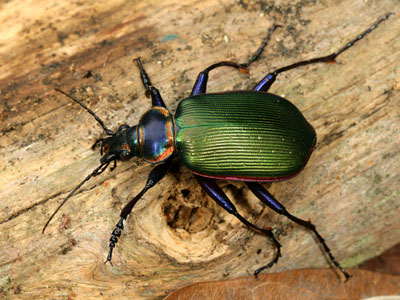The Cankerworm Chronicles

Editor’s Note: This is a guest post by Amitha A. Narayanan, a graduate student in NC State’s Technical Communication program.
It is the time of the year when you might be thinking of snuggling up with hot chocolate and your favorite book, but female cankerworm moths are hard at work – laying the foundation for an invasion that you won’t notice until this spring.
The cankerworm moths are making their inexorable, perfectly camouflaged march up tree trunks, to mate and lay thousands of neatly stacked rows of barrel-shaped eggs on the limbs of our trees. Three months from now, when spring brings the sun, the tiny green baby worms squiggle out of the eggs, one at a time. Once out, they feed on tender spring leaves, parachute down from the trees on silken threads, and finally drop to the ground to pupate and repeat the cycle. They might be small and sluggish, but the baby worms are voracious eaters. They can chew an entire oak canopy in a matter of two days.
They love willow oaks. However, this does not mean they will keep looking for a willow oak till they find one. “The adults that crawl up cannot tell the difference between a tree and a totem pole,” says Alex Johnson, the Durham County Urban Forestry Manager. Willow oaks are more susceptible to cankerworm trouble because of their abundance. They are also the tallest trees in the urban canopy. “As part of their reproduction and dissemination strategy, the cankerworms try to get to the top of the tallest tree,” adds Johnson. And the hatching of the baby worms coincides with the budbreak in the willow oaks. In more ways than one, willow oaks seem to be the perfect hosts for these worms.

In the feeding melee, old trees are often the worst hit. When the leaves emerge in spring and are devoured by the hungry baby worms, the tree is forced to tap into its reserves to create more leaves. The older the tree, the higher the amount of live tissue and greater the number of systems that need to be supported with the limited photosynthetic potential, thanks to the leaves not being able to do their jobs. The repeated defoliation can ultimately kill the tree.
The worms seem to have a preference for urban life, because outbreaks tend to happen more often in cities than in forests. It is not that the worms are not present in the forests; it is just that they don’t cause infestation and defoliation on the same scale as they do in cities. When Steve Frank, an entomologist at NC State, studied this trend further, he found that it might be the lack of plant diversity in urban environments that makes the trees more susceptible to repeated infestation.
“If the cankerworm pupates in a forest and climbs up the tree, it might not be a host. But in a city, it is most likely the same tree that was infested in the previous year,” says Frank.
Another factor is the fewer number of natural predators like birds, bugs, beetles, and spiders in the cities as compared to forests, where life is pretty treacherous for the cankerworm. A wrong landing could mean the difference between life and death. Also, the forest habitat is complicated with different kinds of short trees, tall trees, shrubs, flowers, and so on. The Fiery Searcher (Calosoma scrutator), a metallic rainbow colored ground beetle that climbs up trees to feed on the worms, is a particularly formidable opponent of the cankerworm, but is almost nonexistent in the urban setting.
Understanding worm flare-ups
Cankerworms go through periods of abundance ranging from two to seven years, followed by periods of low populations.
“About twenty years ago or so, they got bad in Charlotte, and they stayed bad every year since then. Raleigh and Durham seem to be reaching a similar state too,” says Frank.
At its worst, “thousands of worms were falling out of the trees, and completely demolishing every leaf on affected trees, to the point where trees had to leaf out twice, which put a lot of stress on them. With the worms climbing back up, it was like Fear Factor,” remembers Christina Headrick, former resident of the Trinity Park neighborhood in Durham. Julia Borbely-Brown, also from the area, remembers how residents would shelter their kids from the falling worms as they ran home from their cars parked in the driveways. And in spring, the residents also had to witness the unpleasant spectacle of poppy-seed-like worm poop all over their yards.
There are several theories as to why the cankerworms became a huge problem in the Triangle area in the last couple of years. Katie Rose Levin, the Natural Resources Manager at Duke University, observes that the places on Duke’s campus with the worst infestation are the areas with a simple forest structure, which makes it difficult for natural predators to hide. “We have a monoculture of the preferred species they eat, and all of these trees are very old and weak, so they can’t put up much of a fight,” says Levin. In addition to the monoculture, the urban setting coupled with naturally higher temperature settings can also be a contributing factor. “Spring is arriving earlier. Worms are emerging earlier, so by the time the migratory birds arrive, the worms are bigger, so the birds need eat only a few of them, than they would have normally fed on,” says Levin.
Another factor is the decline in the numbers of neotropical migrant songbirds. “Their migratory patterns have shifted leading to the predator-prey relationship not lining up,” says Johnson. The adult moths are the easiest to be eaten, but when they emerge in winter, there are not many predators around.
Bands (to the) aid
But there may be light at the end of the tunnel. In this case, it is in the form of sticky glue barriers strapped to tree trunks. These bands trap the adults on their road to reproduction. While residents in Durham borrowed the banding idea from big sister Charlotte, Frank and his team at NC State found a paper dating back to 1780, which described banding done for cankerworms in apple orchards by melting tar and putting it on tree trunks. Whether it has been around for a long time or not, banding seems to be the most effective method in “interrupting their reproductive cycles without taking a toll on non-target insects,” says Johnson.
On the Duke University campus, Levin and her team experimented with bands on 50 trees and chemical injections on 30 trees to increase their resistance to cankerworm infestation. While the ones that were given the chemical treatment fared the best, the ones that were banded did quite well too. They noticed a huge difference between the trees that were banded and those that were not.
On the NC State campus, Frank’s team banded 36 trees; 12 with one band, 12 with two, and 12 with no bands. This “Cankerworm Project” caught 18,000 cankerworms.
Headrick also found the banding technique to be really effective in her neighborhood. “It probably cut our worm problem in half. We easily killed several thousand worms and moths in the last two years that we banded, 2012 and 2013,” says an enthusiastic Headrick.
The cankerworms spread by ballooning down and feeding all the way to the ground. Sometimes on their way down, they fall on other trees and feed again. By this dissemination mechanism, they spread to other trees and lower level vegetation like shrubs and rose bushes. So, banding is more effective when it is done thoroughly on the larger trees as well as on a large number of trees in an area. Timing also plays a very crucial role in the success of banding. Because frost triggers the emergence of the adult moths from the ground and their march up the trees, an early frost can cause problems. However, if you get ahead of yourself and have your bands up there before the leaves fall, “the leaves will get trapped on the bands and the moths can crawl right over it,” says Johnson. Another critical step is to ensure that the bands are taken down in early or mid-March. It might seem like extra work, but the bands do not hold up year after year.
“If they stay on the trees, they give rise to microclimates for other worms to burrow. So take it down and reapply,” is Johnson’s take on post-banding maintenance.
Work in progress
Efforts are on to increase awareness about the problem on campuses as well as neighborhoods in the area. On the NC State campus, a banding project in 2014 saw 70 to 80 bands go up during the student-parent weekend. The next step might be to “have undergraduates in horticulture and entomology do service projects where they could help,” says an optimistic Frank, who believes that increasing participation at the grassroots level is the way forward.
The Durham County Sustainability Office has been working closely with campuses like Duke to conduct workshops for increasing awareness about the problem as well as educating people about banding. There are banding kits people can check out from the Durham County Main Library. The kits also include information about social media handles like Twitter and Instagram hashtags and QR codes for websites on which people can find more information. For Halloween this year, the kits even came with some masks.
There are also individual champions like Johnson and Borbley-Brown, who do their bit in getting the information out there as far and wide as possible. Johnson writes a monthly newspaper article and Borbley-Brown manages a listserv of 2,100 people, which she uses to educate people. She also put together banding kits that people in the neighborhood can purchase. Hers is a two-pronged approach; educate people and provide them with the resources to implement what they’ve learned. Johnson believes that there is nothing more compelling than success. “When there is reduction in the number of cankerworms, people take notice,” he adds. Let us hope that the plans of action meet with enough success for people to take notice and take it upon them to see the project forward.
- Categories:


